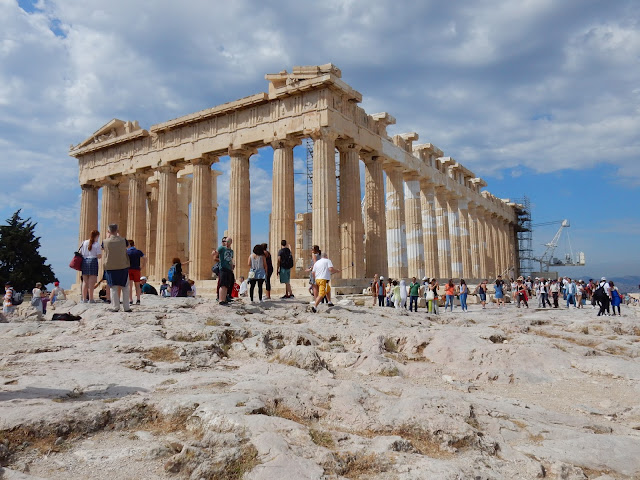We
visited Athens in 1976, just two months before we moved from England to the
states. Other than our vivid memories of the Acropolis, we didn’t remember much
of the city—except for the constant sound of blaring car horns, which we could
hear day and night—and the food, which was delicious.
From
the port of Piraeus, we caught the Hop-On, Hop-Off bus for a tour of Athens. The
system has four separate lines, and we had the option of buying tickets for two
lines or four. We opted for two lines, one that took us through the Piraeus
coastline, and the other around Athens. We discovered that if we had presented
our tickets from bus tours in other cities and countries that we would have
received a discount on our tickets. Next time we’ll know.
We
arrived on the Monday following the Greek Orthodox Easter, a major holiday in
Greece—the deserted streets and houses still shuttered midmorning evidence that
the people of Greece were recovering from the celebrations.
The
route through Piraeus took us past small harbors with large yachts. We traveled
up and down narrow streets bordered by apartment buildings with balconies
filled with flowers and shrubs. Olive trees and trees heavy with oranges lined
the streets. We could almost reach out from the upper deck of the bus and pick them.
The rooftops were dotted with solar panels, which were probably quite effective
with all the sunshine they get in Greece.
The
beaches we passed along the Piraeus coast were narrow and shell-covered.
However, they area was filled with tavernas and bars that apparently come alive
at night.
The
planetarium in Piraeus is supposed to be one of the finest in the world. I wish
we could have visited it, especially since we had experienced few nights clear
enough to see the stars at night.
Our
first stop in Athens was at the Acropolis. It was only the beginning of May,
not the height of tourist season, and by the time we arrived at approximately
10:00 a.m. hundreds of people were already standing in line in front of a small
kiosk for tickets. They had only one line for credit cards and two for
cash—which were hardly used. Once we got tickets, we joined another long line
to show our tickets and go through a turnstile. Lesson: Be at the Acropolis at
9:00 a.m. when it opens.
Acropolis
We
found ourselves among a large group of Japanese tourists, climbing long flights
of marble stairs to the Acropolis. The Acropolis is a plateau of rock that
towers over the city. It holds the Parthenon, amphitheater, and other temples. So
many people were on the Acropolis that it was like being among ants swarming on
an anthill. Thousands of school students from all over world milled about. Dressed
in jeans, short-shorts, and T-shirts, they could have been from anywhere. The
only way we could tell where they were from was hearing them speak as we walked
by.
Propylaia
- Entryway to the Acropolis
The
stairs and surface of the Acropolis were polished to a high sheen from millions
of people treading on them century after century. We had to be careful where we
walked since the rocky stone was smooth and slippery, even when dry. There were
few hand railings. It would have been extremely difficult to climb to the top
and walk about if the surfaces had been wet.
Acropolis
Rocky Surface
The
Acropolis provided a magnificent view of Athens below us and well into the
distance. Church bells rang out from below, but other than that and the chatter
of people around us, it was fairly quiet. Which is a far cry from the Athens of
1976 when you could barely hear over the sound of car horns. That was a good
change for the city.
Scaffolding
covered a portion of the Parthenon. Someone said that they are dismantling the
restoration work done during the 1960s, which apparently hadn’t been done
correctly or authentically.
Seeing
the Parthenon takes your breath away. When you see a historic place, some
thousands of years old, it is hard to put into perspective just how old those
places are. The Parthenon had been standing long before St. Paul the Apostle
preached near the Acropolis two thousand years ago.
Parthenon
– Temple to Athena
To
the left of the Parthenon stands the Erechtheion, containing the Porch of the
Caryatids and statue of the maidens that carry the weight of the porch.
Erechtheion
and Porch of the Caryatids (Maidens)
Built
into the hillside of the Acropolis rests the Odeon of Herodes Atticus, an
amphitheater where plays and concerts are still performed.
Odeon
of Herodes Atticus
Panathenaic Stadium
Parliament
Building and the Tomb of the Unknown Warrior
Unlike
many other cities we’ve visited, none of the signage was in English, and you
really needed to know the Greek name for the place you wanted to see or the
street name. The streets were named for fourth century battles.
A
subway system was constructed before the Olympics were held in Athens a few
years ago. During the excavations, a number of archeological finds were
uncovered and later used as exhibits in the stations close to where they were
discovered.
As
much as I enjoyed being in Athens, a place where the foundations upon which
modern government and democracy were based, I found it distressing to see the
city covered in graffiti. But people leaving their mark on Greece isn’t
something new. Outside of Athens at Cape Sounion stands the Temple of Poseidon
on which people, including Lord Byron, carved their names and initials for
centuries.
Acropolis
from a City Square










No comments:
Post a Comment